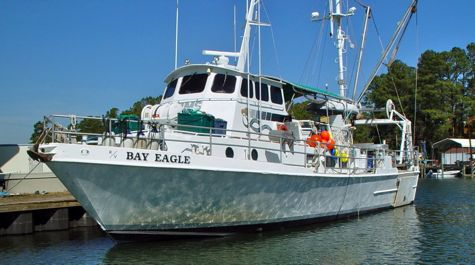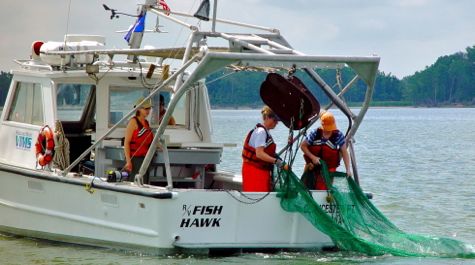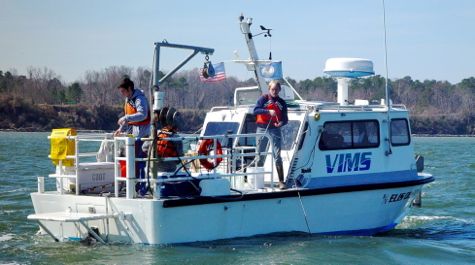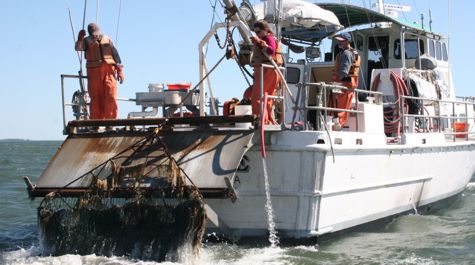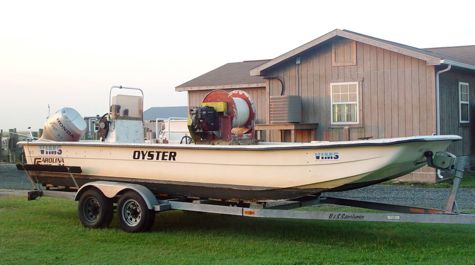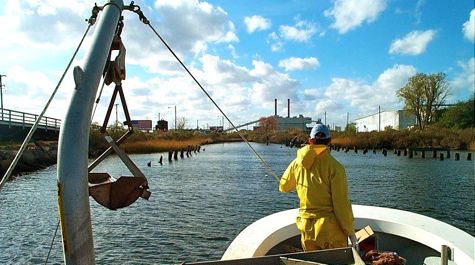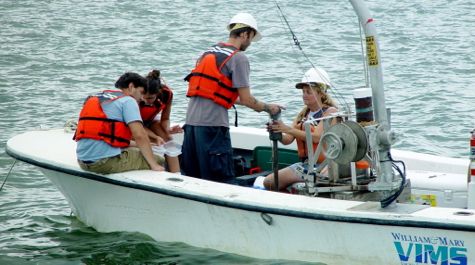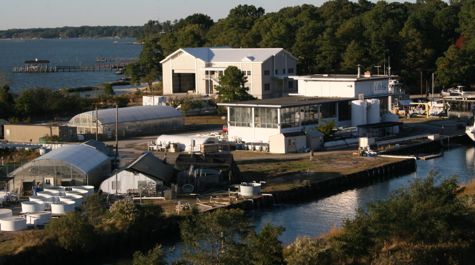VIMS research vessel takes part in OpSail parade
The RV Bay Eagle—65-foot flagship of the Virginia Institute of Marine Science’s fleet of research vessels—took part in yesterday’s Sea and Air Parade of Sail, the initial on-water event of OpSail 2012 Virginia.
OpSail is a periodic gathering of tall ships, navy vessels, and other watercraft from around the world. OpSail 2012 is the seventh such event, each marking a landmark episode in American history. This year’s OpSail commemorates the 200th anniversary of the War of 1812, a watershed conflict that helped determine the future of the U.S., Britain, Canada, and several Native American tribes.
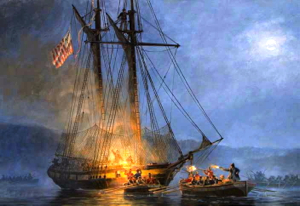
The Bay Eagle's participation in this year's OpSail event was particularly appropriate given its home port of Gloucester Point, site of "one of the most hotly contested revenue cutter engagements of the war," a June 12, 1813 skirmish involving the U.S. Coast Guard cutter Surveyor and the 32-gun British frigate HMS Narcissus in the waters off of VIMS' bayfront campus.
Previous OpSail events took place in 2007 (400th anniversary of Jamestown), 2000 (new millennium), 1992 (500th anniversary of Columbus' landing), 1986 (Statue of Liberty's centenary), and 1976 (American Bicentennial). The first event, in 1964, occurred in conjunction with the New York World’s Fair.
In addition to the Bay Eagle, the Sea and Air Parade featured an international fleet of naval vessels, as well as waterborne and air assets from the U.S. Navy, U.S. Coast Guard, NOAA, Army Corps of Engineers, and other government and private organizations. The parade began just outside the Chesapeake Bay mouth, and then passed through Thimble Shoals Channel, past Hampton, and into downtown Norfolk along the Elizabeth River. Thousands of local residents and visitors watched from shore and boats in Virginia Beach, Fort Monroe National Park, Newport News, Norfolk, and Portsmouth.
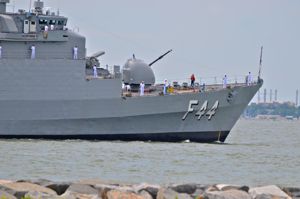
The Bay Eagle, piloted by Captain Durand Ward with assistance from Captain John Olney, Jr., paraded between two sizable naval vessels, the 450-foot HDMS Esbern Snare of the Royal Danish Navy, and the 370-foot BAP Villavisencio, a Peruvian Navy frigate. Leading the parade was the 109-foot U.S. Coast Guard cutter Shearwater, followed by the USS Anzio, a 567-foot Ticonderoga-class guided missile cruiser.
Ward describes the parade as “a festive occasion,” despite 15- to 20-knot winds and a 3- to 4-foot chop, and says, “It was nice to be able to represent VIMS and its marine-research capabilities.” He notes that the experience was markedly different than his regular trips aboard the Bay Eagle. Those are typically research cruises to Virginia’s coastal ocean and Chesapeake Bay for VIMS’ Shark Survey, Winter Blue Crab Dredge Survey, and Chesapeake Bay Multispecies Monitoring and Assessment program (ChesMMAP).
VIMS Research Fleet
The Bay Eagle is one of 40 vessels in VIMS’ research fleet, most named after marine birds. The fleet also includes the 29-foot R/V Fish Hawk, the platform for VIMS’ Juvenile Abundance Monitoring surveys; and the 29-foot Ellis Olsson, used mostly for geophysical studies by scientists with the Coastal Hydrodynamics and Sediment Dynamics Lab at VIMS.
The VIMS fleet also includes 28 trailerable boats that support estuarine and tributary research. VIMS also operates a number of smaller vessels at its Eastern Shore Lab in Wachapreague, the Virginia Estuarine and Coastal Ocean Observing System, the Dataflow and Acrobat sensors, and the autonomous underwater vehicle Fetch II.
Professor Carl Hobbs, Director for Operations, Support Services and Special Programs at VIMS, has compiled data showing the scope of the Institute’s vessel operations. In 2011, the Bay Eagle was at sea on 83 days for 1,151 hours of service, while the R/V Fish Hawk was at sea on 135 days (1,105 service hours). The trailerable fleet, used by VIMS faculty, staff, and students for a wide variety of research projects, recorded 911 days at sea in 2011, up from 830 days in 2010.
Hobbs explains that the Bay Eagle, Ellis Olsson, and Fish Hawk operate with Coast Guard licensed captains and regular crews. “Those who operate the small boats must have completed either the Coast Guard Auxiliary or U.S. Power Squadron boating safety courses,” says Hobbs, “and must be up-to-date in CPR and First Aid training. They also undergo a period of mentorship before being allowed to take on the responsibility of being an operator-in-charge.”
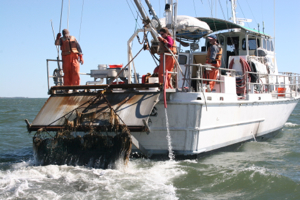 The Bay Eagle is outfitted with a wet lab containing a flow-through seawater system, and a dry lab housing electronic instruments. It has two boom winches and redundant hydraulic systems to accommodate a variety of scientific needs and data collections. The vessel also uses interchangeable stern decks that increase its versatility when changing from trawling to dredging, long lining, or other applications.
The Bay Eagle is outfitted with a wet lab containing a flow-through seawater system, and a dry lab housing electronic instruments. It has two boom winches and redundant hydraulic systems to accommodate a variety of scientific needs and data collections. The vessel also uses interchangeable stern decks that increase its versatility when changing from trawling to dredging, long lining, or other applications.
The Bay Eagle, which has been in service at VIMS since the mid-1980s, is scheduled to be replaced by a new vessel, with funding approved by Virginia’s General Assembly during its 2011-12 session.
“While the formal planning process is in its earliest stages, we think it will be at least three years until the new vessel could be available for service,” says Hobbs. “In order to calibrate survey results so that the data would be comparable between the Bay Eagle and the new boat, the two vessels will have to work in tandem for at least a year before the older vessel can retire.”


